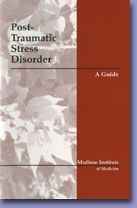
| Table of Contents | |
| Excerpt 1 | |
| Excerpt 2 | |
| Testimonials | |
| Authors John H. Greist, MD, James W. Jefferson, MD and David J. Katzelnick, MD |
|
Posttraumatic Stress Disorder: A Guide (Excerpt 1) After exposure to an extremely traumatic experience, some individuals reexperience the traumatic event in recollections, flashbacks, nightmares or after encountering reminders of the event. They may also develop emotional numbing and avoid situations that trigger unpleasant memories. Despite emotional numbing, many individuals with PTSD also have increased arousal or alertness. For a diagnosis of posttraumatic stress disorder, all three of these characteristics (reexperiencing, emotional numbing and avoidance, and increased arousal) must be present for more than one month. Let�s explore these characteristics in more detail. Reexperiencing the traumatic event. Most of us remember events, both positive and negative, from our past. Those who suffer PTSD have unwanted, intrusive and distressing recollections of the traumatic event. These range from mildly disturbing memories to flashbacks in which it feels as though the traumatic event is occurring again while the person is awake, or nightmares in which frightening fragments of the entire traumatic event are replayed in dreams. Rarely, at its most extreme level, the person may react both emotionally and physically as though caught up again in the traumatic event. Emotional numbing and avoidance. Given the unpleasant nature of reexperiencing a traumatic event, there is a certain logic to numbing and avoidance. Unfortunately, the numbing (sometimes called emotional anesthesia) often spreads to involve many important and previously enjoyable activities in addition to those associated with the rauma. Sufferers often describe having a more restricted range of emotions with fewer highs and lows and feelings of detachment from others, including those with whom they had been close before PTSD began. Avoidance may be seen as the ultimate form of numbing. Increased arousal. Those who have experienced trauma often describe a loss of innocence and trust in their safety and surroundings. They become hypervigilant, watching for danger and often have an exaggerated startle reaction to stimuli that most individuals would hardly notice. Because of increased arousal, individuals with PTSD often have difficulty concentrating and falling or staying asleep and may display irritability because they are always on edge. As the above description shows, PTSD is a difficult and distressing disorder.
|